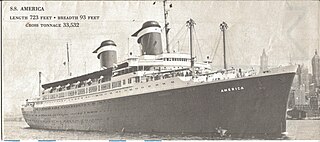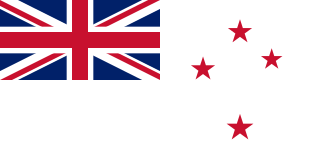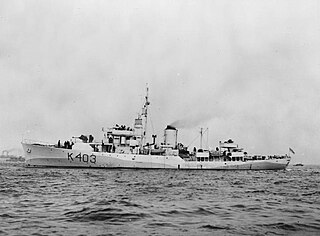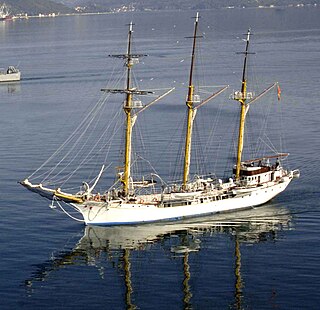
The Royal New Zealand Navy is the maritime arm of the New Zealand Defence Force. The fleet currently consists of nine ships. The Navy had its origins in the Naval Defence Act 1913, and the subsequent purchase of the cruiser HMS Philomel, which by 1921 had been moored in Auckland as a training ship. A slow buildup occurred during the interwar period, and then perhaps the infant Navy's most notable event occurred when HMS Achilles fought alongside two other Royal Navy cruisers at the Battle of the River Plate against the German ship, Graf Spee, in December 1939.

RFA Argus is a ship of the Royal Fleet Auxiliary operated by the Ministry of Defence under the Blue Ensign. Italian-built, Argus was formerly the container ship MVContender Bezant. The ship was requisitioned in 1982 for service in the Falklands War and purchased outright in 1984 for a four-year conversion to an Aviation Training Ship, replacing RFA Engadine. In 1991, during the Gulf War, she was fitted with an extensive and fully functional hospital to assume the additional role of Primary Casualty Receiving Ship. In 2009, the PCRS role became the ship's primary function. Argus is due to remain in service beyond 2030. In July 2022 it was reported that the future Littoral Strike Role would be assumed by Argus after a refit to convert her to this role. As of October 2023, Argus had started her deployment to serve as part of Littoral Response Group (South) based out of the UK Joint Logistics Support Base in Oman.

The Dido class consisted of sixteen light cruisers built for the Royal Navy during World War II. The first group of three ships were commissioned in 1940; the second group of six ships and third group of two were commissioned between 1941 and 1942. A fourth group, also described as the Improved Dido or Bellona class were commissioned between 1943 and 1944. Most members of the class were given names drawn from classical history and legend. The groups differed in armament, and for the Bellonas, in function. The Dido class were designed as small trade protection cruisers with a secondary role in the battlefleet as large flotilla leaders. As designed, they mounted five twin 5.25-inch high-angle gun turrets on the centreline providing dual-purpose anti-air and anti-surface capacity; the complex new turrets were unreliable when introduced, and somewhat unsatisfactory at a time when the UK faced a fight for survival. During the war, the original 1939-42 ships required extensive refit work to increase electrical generating capacity for additional wartime systems and in the final Bellona,HMS Diadem, fully-electric turrets. While some damage was experienced initially in extreme North Atlantic weather, changes to gun handling and drill partially mitigated the problems. The fitting of the three forward turrets in the double-superfiring A-B-C arrangement relied upon the heavy use of aluminium in the ships' superstructure, and the lack of aluminium after the evacuation of the British Army from France was one of the primary reasons for the first group only receiving four turrets, while the third group received four twin 4.5-inch mounts and no 5.25-inch guns at all. The Bellonas were designed from the start with four radar-directed 5.25-inch gun turrets with full Remote Power Control and an expanded light anti-aircraft battery, substantially increasing their efficiency as AA platforms.
HMNZS Charles Upham (A02) was a Mercandian 2-in-1 class roll-on/roll-off vessel operated by the Royal New Zealand Navy (RNZN) between 1994 and 2001. The vessel was built for the Danish shipping company Mercandia during the early 1980s, and operated under the names Mercandian Queen II and Continental Queen II. The New Zealand Defence Force had identified the need for a logistic support ship as early as the 1970s but it was not until the 1991 white paper that planning to acquire a ship commenced in earnest. Mercandian Queen II was for sale around that time, and although not as capable as the RNZN had initially specified, was purchased in 1994.

SS America was an ocean liner and cruise ship built in the United States in 1940 for the United States Lines and designed by the noted American naval architect William Francis Gibbs. It carried many names in the 54 years between its construction and its 1994 wreck: SS America ; troop transport USS West Point; and SS Australis, Italis, Noga, Alferdoss, and American Star. It served most notably in passenger service as America and the Greek-flagged Australis.

HMS Royalist was a Bellona-class light cruiser of the Royal Navy (RN) during the Second World War.

The history of the Royal New Zealand Navy leads back to early New Zealand-based gunboats used in controlling the British interests in the new colony, as well as to the strong linkages to the British Navy itself.

The Turbine Steamship Fairsky was a one-class Italian-styled passenger ship operated by the Sitmar Line, best known for service on the migrant passenger route from Britain to Australia from May 1958 until February 1972. After a 20-month lay-up at Southampton, Fairsky completed two further voyages to Australia, before returning to be based at Sydney as a popular full-time cruise ship, until striking an unmarked wreck in 1977 which rendered the vessel uneconomic to permanently repair. The ship was finally sold to a Philippines based consortium, intended for static use as a casino and floating hotel. In 1979 during refurbishment at Manila Bay for her new role, a fire broke out onboard which destroyed the accommodation. The wreck was towed to Hong Kong for demolition in 1980.

HMNZS Taranaki (F148) was a modified Rothesay-class frigate in service with the Royal New Zealand Navy (RNZN) from 1960 to 1982. Along with her sister ship Otago, the pair of ships formed a core part of the RNZN escort force throughout the 1960s and 1970s. She was named after Taranaki Province.

HMNZS Otago (F111) was a Rothesay-class frigate acquired from the United Kingdom by the Royal New Zealand Navy (RNZN) before completion.

USS Pinkney (APH-2) was a Tryon-class evacuation transport that was assigned to the U.S. Navy during World War II. Pinkney served in the Pacific Ocean theatre of operations and returned home safely post-war with six battle stars but missing 18 crew members who were killed in action.

The Taiyō-class escort carrier was a group of three escort carriers used by the Imperial Japanese Navy (IJN) during World War II. Two of the ships were built as cargo liners in the late 1930s and subsequently taken over by the IJN and converted into escort carriers, while the third ship was converted while still under construction. The first ship converted, Taiyō, ferried aircraft and supplies to Japanese possessions before the start of the Pacific War in December 1941 and also served as a training ship between transport missions. Once the war began she did much the same for the newly conquered areas. Her sister ship, Un'yō did much the same in 1942. Chuyō, the last of the three to be converted, only ferried aircraft between Japan and the naval base at Truk before she was sunk by an American submarine in December 1943. Her sisters sometimes had other destinations other than Truk in 1943, but it was also their primary destination until they were damaged by American submarines in late 1943 or early 1944. After finishing their repairs in 1944, the sisters combined convoy escort duties with their transport missions and often ventured as far south as Singapore. Taiyō was the first of the pair to be sunk, torpedoed by an American submarine in August, with Un'yō following her sister a month later.

The military history of New Zealand during World War I began in August 1914. When Britain declared war on Germany at the start of the First World War, the New Zealand government followed without hesitation, despite its geographic isolation and small population. It was believed at the time that any declaration of war by the United Kingdom automatically included New Zealand; and the Governor announced that New Zealand was at war with Germany from the steps of Parliament on 5 August.

HMNZS Arbutus was a modified Flower-class corvette of the Royal New Zealand Navy (RNZN). Built for the Royal Navy as HMS Arbutus, the corvette was transferred to the RNZN on completion in 1944, and operated in the British Pacific Fleet during the final year of World War II. In April 1947, Arbutus was one of the units involved in a mutiny over poor pay and working conditions. She was decommissioned in 1948 and broken up for scrap in 1951.

HMNZS Canterbury (F421) was one of two broad beam Leander-class frigates operated by the Royal New Zealand Navy (RNZN) from 1971 to 2005. She was built in Scotland and launched in 1970. Commissioned in 1971, Canterbury saw operational service in much of Australasia and other regions like the Persian Gulf. She undertook operations such as supporting UN sanctions against Iraq and peace-keeping in East Timor. With her sister ship HMNZS Waikato she relieved the Royal Navy frigate HMS Amazon in the Indian Ocean during the Falklands War. Early in HMNZS Canterbury's career, in 1973, she relieved the frigate HMNZS Otago, as part of a unique, Anzac, naval operation or exercise at Moruroa during anti-nuclear protests, supported by a large RAN tanker, providing fuel and a large platform for Australian media. This was due to F 421 being a more modern RNZN frigate, with then current Rn surveillance radar and ESM and a more effectively insulated frigate from nuclear fallout, with the Improved Broad Beam Leander steam plant, for example, being remote controlled and capable of unmanned operation and therefore the ship provided a more effective sealed citadel for operations in areas of nuclear explosions.
HMNZS Moa (T233) was a Bird-class minesweeper of the Royal New Zealand Navy (RNZN) that served during World War II.
HMNZS Monowai (A06) was a hydrographic survey vessel of the Royal New Zealand Navy (RNZN). Built in 1960, the ship was originally used as a civilian supply and passenger vessel by the New Zealand Government, under the name GMV Moana Roa, before being acquired by the RNZN in 1974. She was commissioned into the RNZN in 1975 for the voyage to Scotland for conversion and commissioned into the RNZN in October 1977. She remained in RNZN service until April 1998, performing various duties such as coastal surveying, resupply, and surveillance. After being decommissioned she was sold to civilian operators in Britain in 1998 for conversion to a cruise ship, but was found unsuitable for the role and eventually sent to Spanish shipbreakers in 2002.

Vice Admiral Sir Peter Phipps, was a senior officer of the Royal New Zealand Navy (RNZN) from the 1940s to 1960s.

The second USS Comfort (AH-6) was launched 18 March 1943 by Consolidated Steel Corporation, Wilmington, Los Angeles, under a Maritime Commission contract; sponsored by First Lieutenant E. Hatchitt, USAMC; transferred to the Navy the same day; converted to a hospital ship by Bethlehem Steel Co., San Pedro, Calif.; and commissioned 5 May 1944.

Jadran is a sailing ship for basic naval training built for the Yugoslav Royal Navy and currently in Montenegrin Navy service. A three-mast topsail schooner or barquentine with an auxiliary engine, Jadran was built in Hamburg, Germany between 1930 and 1933, and commissioned on 19 August 1933. Prior to World War II she completed seven long training cruises with trainees from the Yugoslav Naval Academy, including one to North America. As Yugoslavia was neutral at the outbreak of World War II, Jadran was able to conduct short cruises in the Adriatic Sea. In April 1941, Yugoslavia was invaded by the Axis powers, and Jadran was captured and renamed Marco Polo by the Italian Navy. She continued to be used as a training ship in the Adriatic, operating out of the Istrian port of Pola, and was featured in an Italian propaganda film.
















